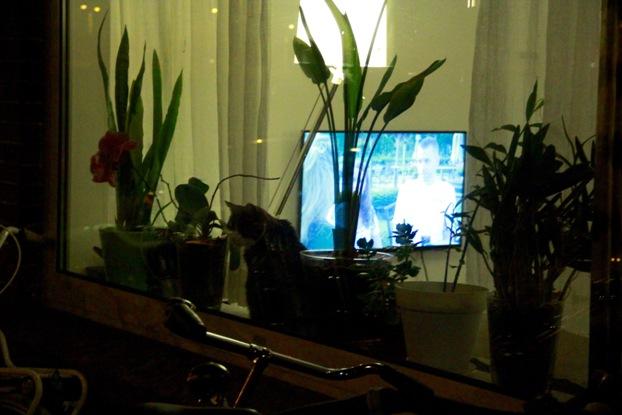Windows to the Dutch way of live

De Poolse Zuzanna krijgt in deze donkere dagen een goed kijkje in het leven van Utrechters. Het licht gaat aan voordat de gordijnen sluiten. Waarom zetten Nederlanders zich zo te kijk? Zuzanna has three theories. A blog in English.
Biking through Utrecht one is granted an access to the Dutch way of life by viewing snapshots of private moments of fellow Utrechters. Taking a walk can satisfy one’s curiosity to an even greater extent. What do the Dutch eat for dinner? Which games are frequently played on PS? What are the latest trends in interior design? How often do they do laundry?
These and many more questions have come to my mind and were often immediately answered when I unintentionally and for a split second played the role of a Peeping Tom before turning my gaze away disconcertedly. The huge windows at the ground level of Dutch homes and a rare use of blinds or curtains leave little to the passersby’s imagination.
This feature of Dutch architecture, and thus also culture, is striking to many foreigners. In Poland, people tend to protect their privacy at home as much as they can. Fences, gates, multiple locks, and thick doors separate the tenants from the outside world. The ground level of most of the buildings is either dedicated to retail and services spaces or the windows are higher than an average person’s sight, or at least, in the last instance, covered by heavy curtains. This is similar in many other countries, in which even the arrangement of rooms in an apartment might aim to divert the unwanted sight away from what is happening inside. Why is it not the case in the Netherlands? So far, I have either come up with or encountered three theories to explain the phenomenon.
First theory
The simplest explanation first – the Dutch, as a highly practical nation, solve the issue of insufficiency of light in their homes by the use of big windows. In a country where the sun is scarce and the streets are often very narrow, each beam of light is greatly valued and desired. Indeed, it is very comforting to let the light and air in on the days when you feel stifled even by the weather itself. In the olden days, it was apparently also cheaper to build bigger windows than thicker walls (which is not a case anymore). However, as the proponents of cultural hegemony suggest, even the items of everyday use and seemingly mundane objects reflect ideology – so is there more to the big windows?
Second theory
Some believe the visibility of the interiors of Dutch homes is a remnant of Calvinist beliefs. After all, who would not want to show off how well their life is going and, by that, their special privilege amongst the predestined? What’s more, leaving the interiors for everyone to see could mean the tenants do not engage in any activities they should be ashamed of. It seems that only people who have something to hide would feel the need to entrench themselves from the scrutiny of their community’s members. And from comparing the customs of my home country to the ones of my host country, it seems that only those from whom the details of other people’s lives are concealed feel the need to scrutinize others. The Dutch just do not stare or care about what they see on the other side of the glass.
Third theory
Finally, to me the big, open windows are quite symptomatic of the Dutch attitude towards one’s neighbors. I was very surprised the first time the mailman left a package for someone living two houses away from me. I’m used to going to the post office to collect the delivery I missed. I wondered, what if someone pretended to know nothing about the package and leave it for themselves? The Dutch system which is much more convenient for all the parties involved, is simply based on a mutual trust. And in a community based on trust and honesty, thick walls, excessive locks or cautiously closed screens are hardly necessary.